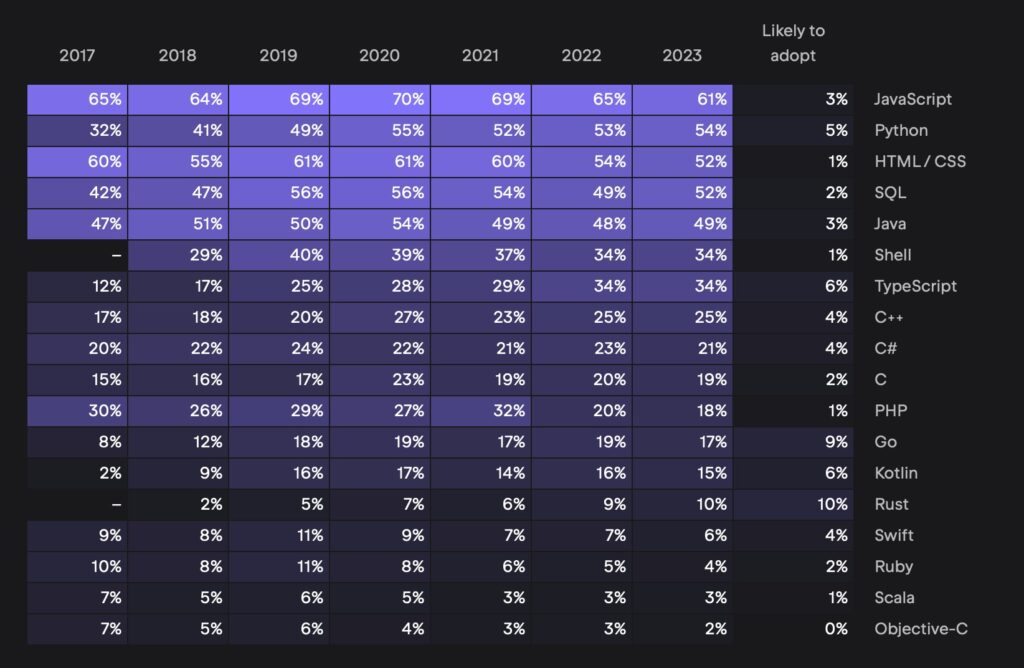
JetBrains has released its annual State of Developer Ecosystem report, including the claim that Apple’s Objective-C language “appears to be reaching its end of life,” with just 2 percent of developers using it and none planning to adopt it.
The report is based on submissions from over 26,000 developers, though the company acknowledges that it may be “skewed towards the views of JetBrains users,” since those users are more likely to participate in the survey despite efforts to reach a wider range of participants.
There are a few reasons why the report may understate both Swift and Objective-C usage, these being the languages supported by Apple for its platforms. JetBrains used to have an IDE for macOS and iOS called AppCode, including both Objective-C and Swift support, but ceased its development in December 2022, saying “we didn’t reach the market share we had hoped for.” The decision left developers using either language lacking support from JetBrains IDEs, though there is early access Objective-C support in CLion, a C++ IDE. The Swift plugin for CLion though has been discontinued since it was based on AppCode. In addition, Apple developers tend to use the official Xcode IDE as the best way to keep up with changes in macOS and iOS.
The report states though that Objective-C was “used by fewer than 2 percent of programmers at least once, and only 11 survey participants reported it as their primary language. The decline in usage of Objective-C has outpaced even that of COBOL and Perl.” The reason given is that Swift is Apple’s successor to Objective-C, and there are also cross-platform languages that target iOS including “Kotlin, Dart and more.”
In May, Redmonk analyst Stephen O’Grady, analysing language trends, stated that “Objective C dropped four spots – a large decline … still, there’s a large body of Objective C code that’s not going anywhere, which means that Objective C’s decline should be gradual.”

Objective-C aside, the big story in language trends is how static they are, though looking back over a longer period one can see the rise of TypeScript (12 percent in 2017, 34 percent today) and Rust (not listed in 2017, now 10 percent), as well as the decline of PHP (30 percent in 2017, 18 percent now). There is little change from 2022 though in the JetBrains report. “The inertia of language traction has proven difficult to overcome,” remarked O’Grady back in May.
AI is a different story. Seventy-seven percent of developers use ChatGPT, and 46 percent GitHub Copilot, according to the report (figures sum to more than 100 percent throughout the survey as many use more than one technology). The top use of AI is for “asking general questions about software development,” or the kind of thing for which Google or Stack Overflow used to be the destination. Close behind is generating code; in fact, 85 percent of AI assistant users do this some of the time. Other top users include generating code comments, explaining bugs, explaining code, and generating tests. What is holding developers back from greater use of AI? Security concerns, according to 59 percent of respondents, or ethical concerns (42 percent), or company policy (28 percent). 60 percent of developers agree though that “AI coding tools will radically change the software development job market.”
Another notable statistic in the report is that 91 percent of respondents report as male, a familiar result for this kind of survey. That said, “the proportion of female programmers under the age of 30 in South Korea has reached 14 percent,” according to the figures, which is attributed to “strategic long-term policies that the South Korean government has been implementing since the mid-1990s,” including legislation and funding. It is an example that “could provide an effective guide to inspire change in countries where the proportion of women in software development roles is less than 4 percent, even among younger workers,” the researchers suggest.
